Easy Apple Jelly Recipe (Just 2 Ingredients)
This post may contain affiliate links. Read my full disclosure here.
Learn how to make apple jelly with no added pectin to enjoy for fresh eating or canning with this easy recipe sweetened with sugar or honey.
The natural pectin in apples prompted the authors of Stocking Up III to call apple jelly “the simplest of jellies” because it is made with only apples and sweetener.
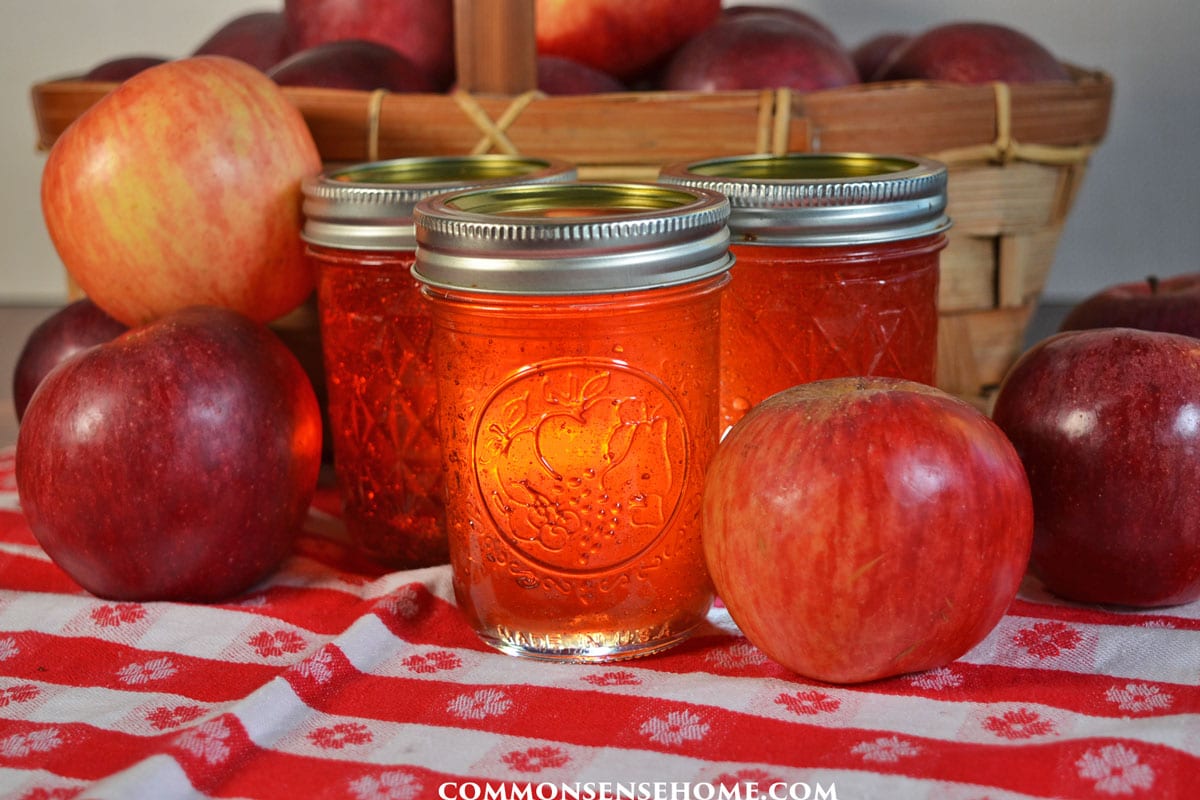
Make a little jelly or a lot – you can use the sweetener guidelines to adjust for the amount of apple juice you have available. You can also make a spiced apple jelly by adding spices during cooking.
Table of Contents
What is Pectin?
Pectin is a fiber naturally found in fruits. It’s a polysaccaride (a type of carbohydrate) that’s used for thickening and gelling. (It can also be used for some health conditions, like treating GERD and binding heavy metals.)
Fruits that are high in pectin include:
- apples
- crab apples
- currants
- grapes
- gooseberries
- plums
- cranberries
- quince
Because apples contain natural pectin, you can make apple jelly without adding artificial pectin. Natural fruit pectin works best for gelling jelly and jam when you have plenty of acid and plenty of sugar.
Tart fruit and less ripe fruit has more pectin than very ripe fruit. To help your apple jelly gel more quickly, be sure to include some less ripe (slightly underripe) apples or crab apples in the mix.
You can also experiment with combining high pectin fruits and low pectin fruits, or making your own homemade pectin. (Apples are often used to make commercial pectin, too.)
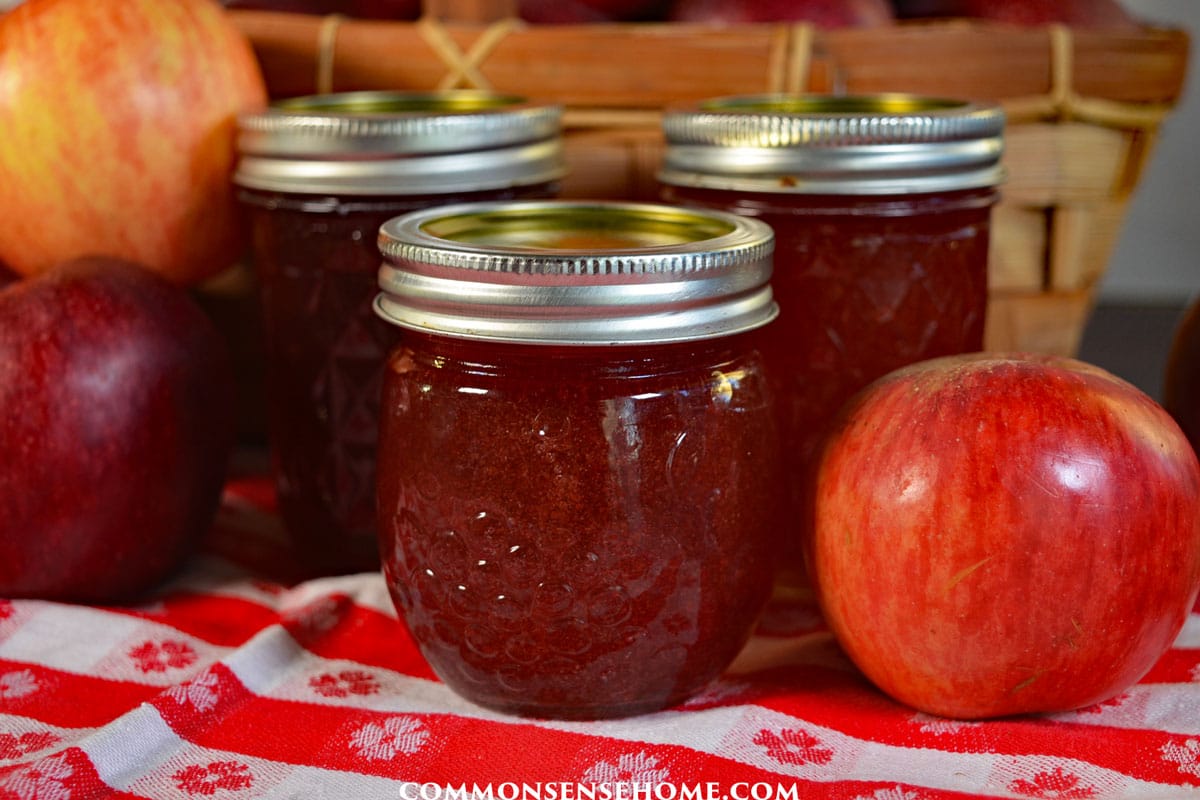
How to Make Apple Jelly with Honey or Sugar
You can use any type of apple for jelly, but varieties with deep red skins add pretty color to your jelly.
Ingredients
- 4-6 cups apple juice (about 6 pounds of apples)
- 3 cups honey or 4-6 cups of sugar
Directions
To juice your apples: Wash apples. Remove stems, damaged areas and blossom ends, cut into quarters or slices.
Don’t peel the apples – much of the pectin is in the peel. Place apples in a non-reactive heavy bottom stockpot (stainless steel or enamel).
Add enough water to half cover apples. Cook until fruit is soft, stirring occasionally to avoid burning and promote even cooking.
If you have sweet apples, you can add 2 tablespoons of lemon juice for a more tart jelly.
You may also make a spiced jelly by simmering whole spices such as cinnamon sticks, cloves or allspice (in a spice bag) with the apples while they are cooking to get soft. (Don’t add them to the boiling juice.)
To strain the apple juice: Place well-cooked apples into a jelly bag strainer or flour sack towel in a colander. If using a towel, gather ends of the towel and hang it from an elevated location. I hang mine from my kitchen cabinet handles because my cabinets are sturdy.
If you have lighter cabinets, hang from the back of a chair or other solid location. You can see my setup in the currant jelly post.
If you want a clear jelly, don’t squeeze the bag to hurry it along – just let it drip. If you like, you can cook your apples one day, let them drain overnight, and make apple jelly the next day.
Apple Jelly Recipe Proportions
Measure out your juice and sweetener:
- 1/2 cup honey for every cup of juice – OR
- 3 cups of sugar for every 4 cups of sweet apple juice – OR
- 4 cups of sugar for every 4 cups of tart apple juice
Measure juice and sweetener into pan. Mix well. Make sure to use a large pot, as the jelly will boil up and foam a great deal during cooking.
Would you like to save this?
This is an 8 quart stockpot, and at times the jelly reached close to the rim. You need to have enough space to reach a full rolling boil.
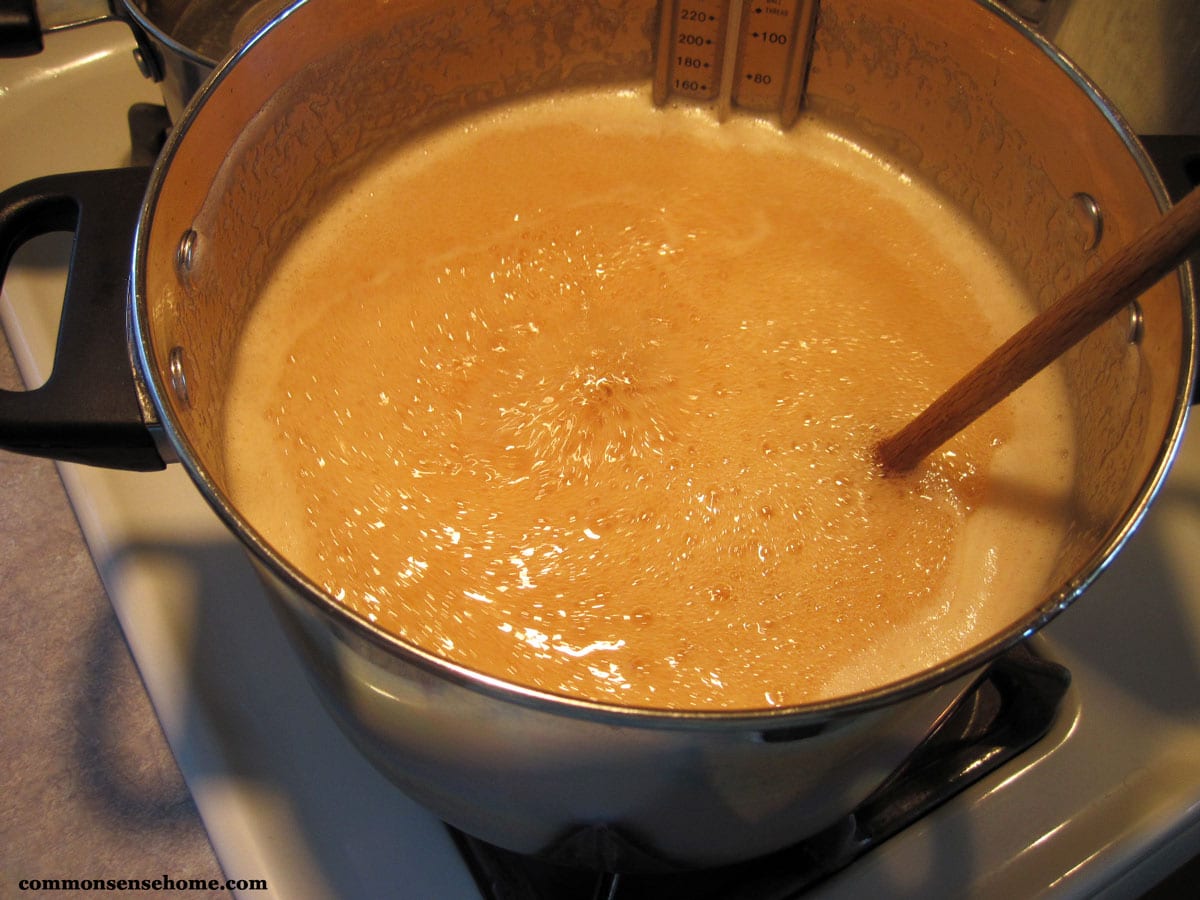
Cook at high heat, stirring constantly, until the gelling point is reached (220°F (104 °C)). When the gelling point is reached, the apple jelly will sheet cleanly off a spoon.
Alternatively, you can place a spoonful of jelly on a cold plate, stick it in the fridge for a minute, and then run your finger through it.
Jelly that has jelled should hold the shape of the finger trail for a bit, not run right back together. When jelling point is reached, remove from heat.

Smaller batches work better than larger batches. I ended up with around 10 cups of juice, so I made a larger batch. It took over an hour to boil down to jelly. Smaller batches cook much faster.
Canning and Processing Time
While the jelly is cooking, prep jars and lids. Jars and lids should be clean and warm, but do not need to be sterilized. I like to heat the lids and rings in hot water, kept warm but not boiling, but this isn’t essential. Fill water bath canner and bring to boil.
Ladle jelly into sterilized jars leaving 1/4″ headspace. Wipe rims clean and screw on the lids. Process for 10 minutes in water bath canner (add 1 minute for every 1,000 feet above sea level).
Makes roughly 5 cups of apple jelly for every 6 cups of apple juice. With 10 cups of crabapple juice and 5 cups of honey I ended up with 8 jars of jelly. The red skinned crabapples gave it a very pretty red color.
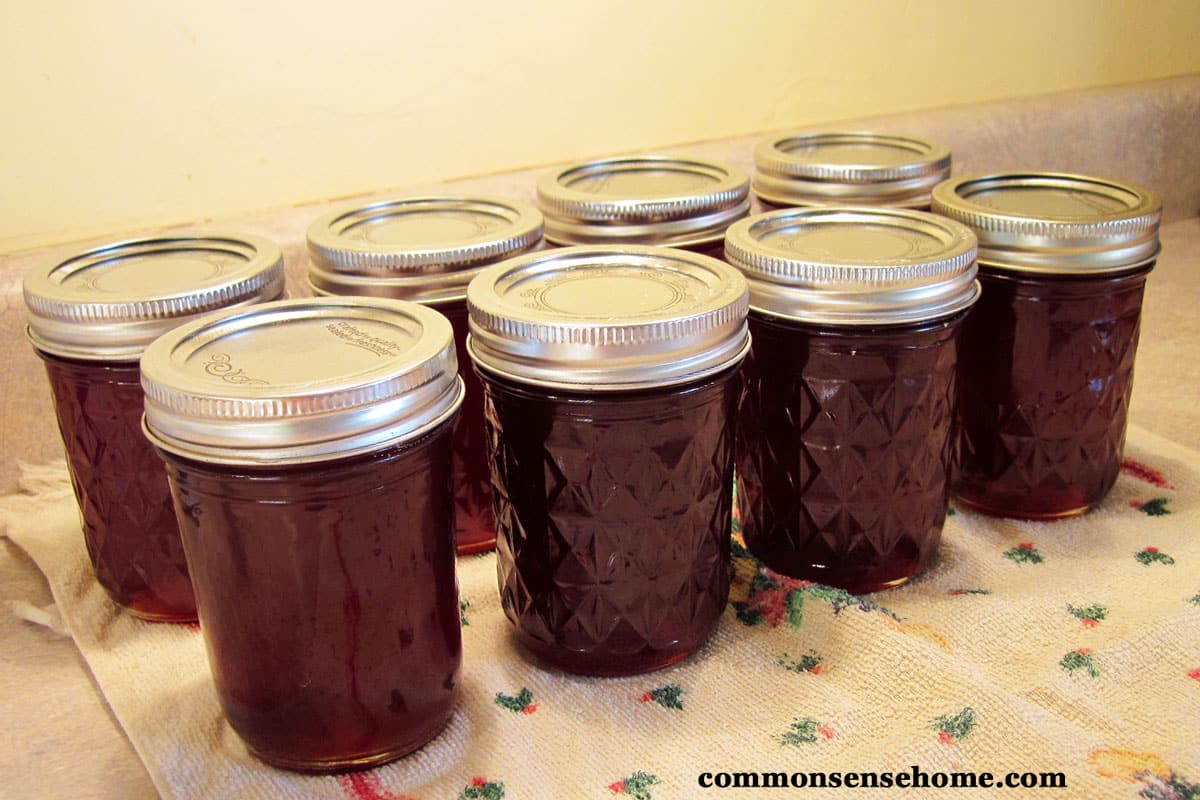
Simple Homemade Apple Jelly
This simple jelly is a great way to use up small or damaged apples to make a delicious treat.
- Prep Time: 10 minutes
- Cook Time: 40 minutes
- Total Time: 50 minutes
- Yield: 4 cups 1x
- Category: Condiment
- Method: Canning
Ingredients
- 4–6 cups apple juice (about 6 pounds of apples)
- 3 cups honey or 4-6 cups of sugar
Instructions
To juice your apples:
Wash apples. Remove stems, damaged areas and blossom ends, cut into quarters or slices. Don’t peel the apples – much of the pectin is in the peel. Place apples in a non-reactive heavy bottom stockpot (stainless steel or enamel). Add enough water to half cover apples. Cook until fruit is soft, stirring occasionally to avoid burning and promote even cooking. If you have sweet apples, you can add 2 tablespoons of lemon juice for a more tart jelly. You may also make a spiced jelly by simmering whole spices such as cinnamon sticks, cloves or allspice (in a spice bag) with the apples while they are cooking to get soft. (Don’t add them to the boiling juice.)
To strain the juice:
Place well-cooked apples into a jelly bag strainer or flour sack towel in a colander. If using a towel, gather ends of the towel and hang it from an elevated location.
Measure out your juice and sugar.
Use
- 1/2 cup honey for every cup of juice – or
- 3 cups of sugar for every 4 cups of sweet apple juice – or
- 4 cups of sugar for every 4 cups of tart apple juice
Cooking and canning the apple jelly.
- Place juice and sweetener into pan. Mix well. Make sure to use a large pot, as the jelly will boil up and foam a great deal during cooking.
- Cook at a high boil, stirring constantly, until the gelling point is reached (220°F (104 °C)).
- While the jelly is cooking, sterilize seven 8-ounce jars, keep hot. Prep two piece canning lids. Fill water bath canner and bring to boil.
- Ladle jelly into sterilized jars leaving 1/4″ headspace. Wipe rims clean and screw on the lids. Process the apple jelly for 10 minutes in water bath canner (add 1 minute for every 1,000 feet above sea level). Makes roughly 5 cups of apple jelly for every 6 cups of juice.
- Once jars have cooled, remove rings, date and label jars. Store in a cool, dark location out of direct sunlight. Use within 18 months for best quality.
Notes
- If you want a clear jelly, don’t squeeze the bag when making juice to hurry it along – just let it drip.
Nutrition
- Serving Size: 1 tablespoon
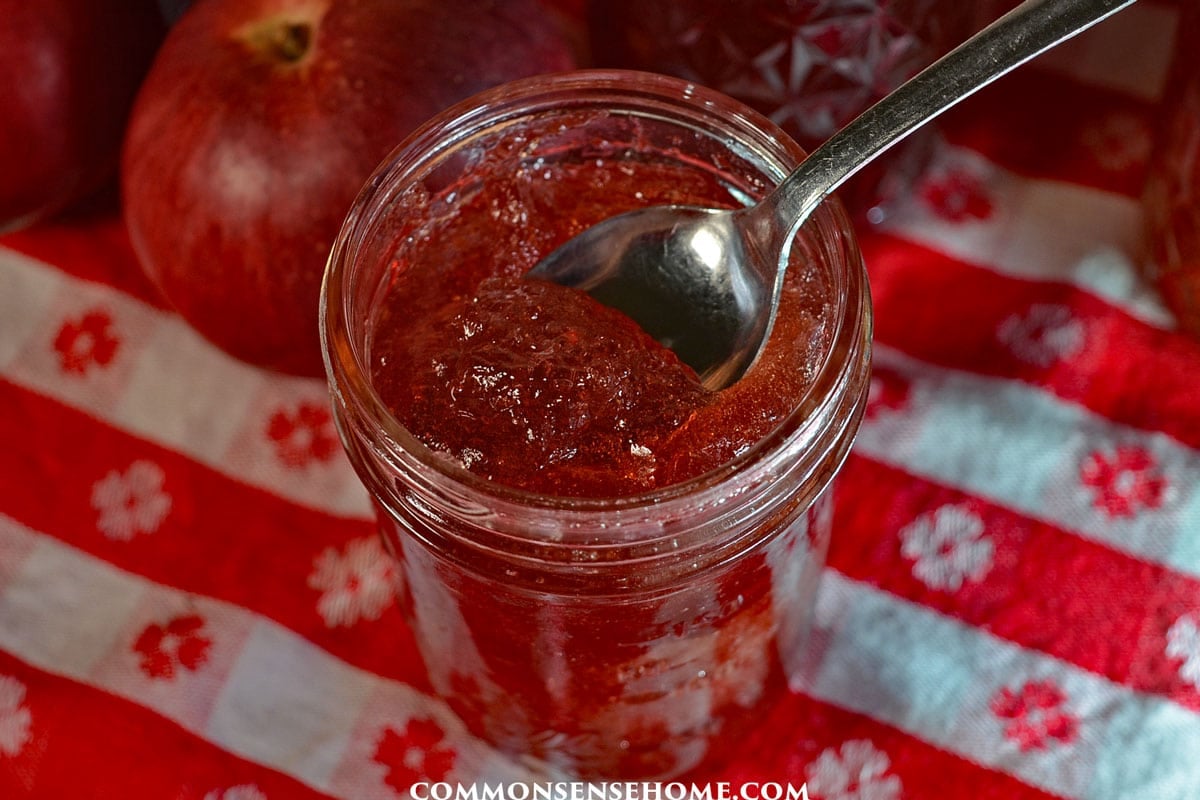
Can I start with apple juice to make jelly?
Yes, you should be able to make apple jelly from commercial apple juice. Most commercial apple juice is quite sweet, so it may take a little longer to gel than juice that includes some underripe apples.
How long does homemade apple jelly last?
If you’d like to cook up a small batch of apple jelly and keep it in the refrigerator instead of canning it, that’s fine.
The high sugar content will keep it shelf stable at room temperature for some time, but refrigeration is safer for longer storage if you don’t can the jelly. While some people feel safe keeping their homemade jelly in the fridge for up to 2 years, we recommend a shelf life of about one year.
Get apple jelly and applesauce from the same apples
This year we had a ton of crabapples gifted to us from a neighbor. I canned 14 quarts whole as honey-cinnamon crabapples, made some into applesauce, and used some for both juice and sauce. It was nice to get two end products out of the same batch of apples.
I cooked the apples up one night and made the jelly the next day, so the juice had time to drain.
After draining the apples for apple jelly, I ran them through our food strainer to make applesauce. This gave us a nice, thick sauce that would be great for fruit leather, since much of the liquid was already removed.
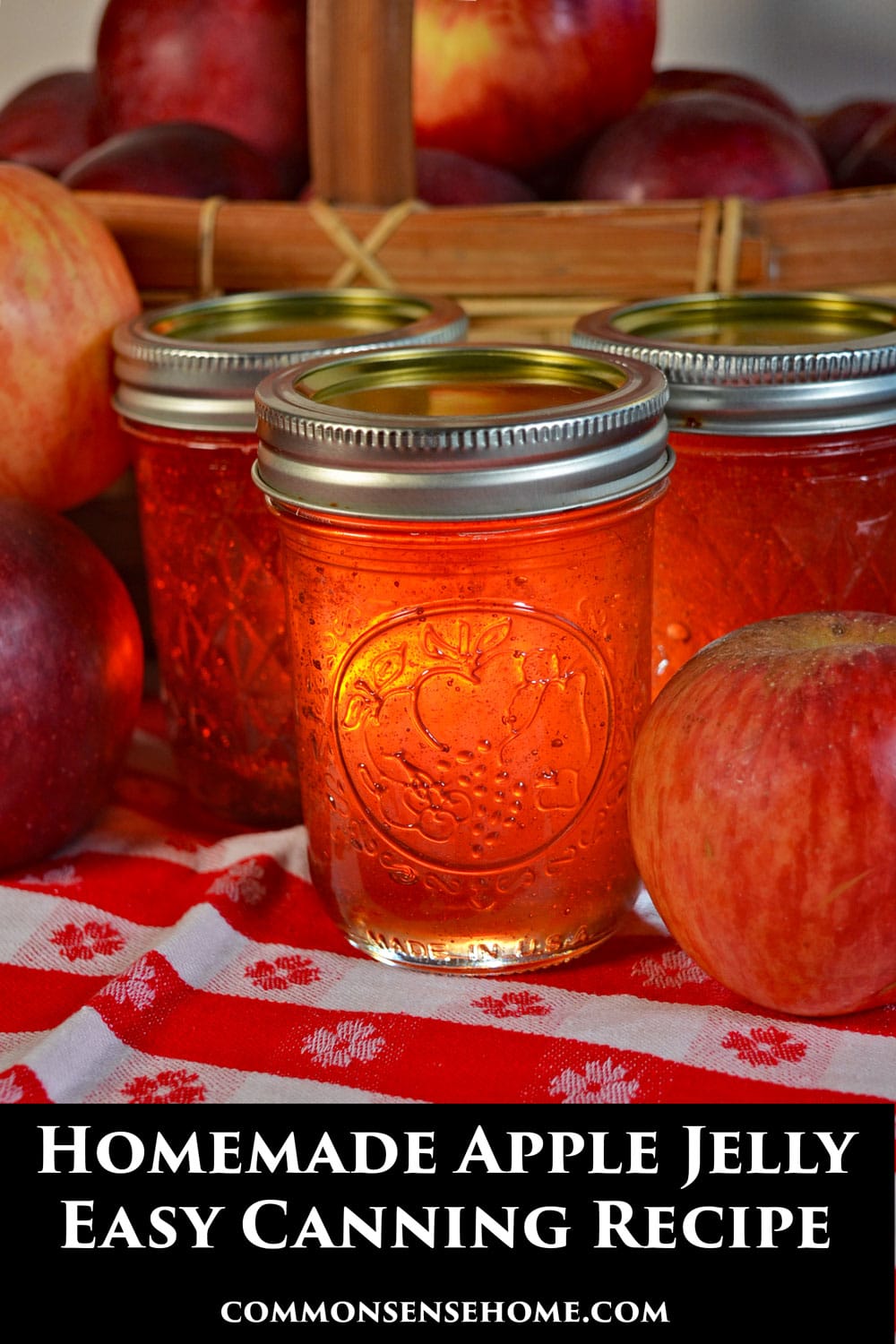
Even more ways to use apples
You can read more about making applesauce and other apple treats in the post, “Preserve Apples for Year Round Use 17 Easy and Creative Ways“. Here are some other recipe ideas using apples:
- Maple Apple Jam
- Apple scrap vinegar
- Hard cider recipe
- Apple cider drink recipes
- Maple fried apples
- Cranberry-apple pie
- Apple crisp
- Easy apple cake with caramel topping
Enjoy!

This article is written by Laurie Neverman. Laurie grew up in the kitchen, learning baking and home cooking from her momma. At age 15, she and her mom and two sisters created Irene’s Custom Cakes & Catering, which was her summer job through most of high school and college.
Last updated in 2024.

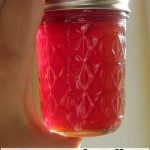



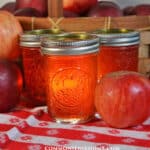
Question on juicing over straining: I was wondering if cooking the apples as instructed and then juicing the cooked apples, rather than staining them (while still reserving the cooking water – just in case) would still be viable. It’s a patience thing for me. Thoughts?
Using a juicer will absolutely result in a juice that will make jelly. The juice obtained via juicer will be more cloudy than strained juice, retaining more solids. Additional pectin is part of those solids, so the cloudy juice may even gel a bit faster than clear juice. If you want a clearer jelly, you could juice with a juicer and then do a quick strain, as the cloudy juice will go through a filter much faster than juice will drip out of apple chunks.
Also, including the cooking liquid is good, as it will give you a higher yield of jelly. There’s a lot of apple goodness infused in that liquid.
It’s my understanding you need to cook everything together and strain to release the natural pectin.
She’s basically “speed straining” via the juicer. The pectin releases during cooking process.
i havefrozen cranberries, can i use these along with the apples? cranberry applejelly?
Yes. Cranberries are also naturally high in pectin.
Apple is one of the simplest recipes for jams and jellies but, I have found that is the hardest to make. Over an hour and a half cook time to get it to jell stage all the while trying to keep it from boiling over. 3 inches in the put that is 14 inches deep. Can’t keep the heat on. Also, the temperature must come to 223 to force the water and pectin to bond for jelling. Great recipe. Taste fantastic.
For a faster cook time, include some underripe apples, which have higher amounts of pectin. You can also use commercial pectin for really fast cook time.
Also, many modern stove concentrate the heat in a small area, which leads to issues with scorching and boiling over. When this might be a problem, I use a product called a SimmerMat, which diffuses the heat more evenly across the bottom of the pot.
Could I use erythritol instead of sugar. I’m a second time cancer survivor, and starting over with a low carb, sugar free diet. An ounce of Prevention is worth a pound of cure!!
If you want to make a sugar free jelly, you’ll need to use commercial pectin formulated for no sugar jelly. The naturally occurring pectin in apples requires sugar to gel. I recommend using Pomona’s Universal Pectin, which gels using a calcium solution (included with the pectin) so you can use any sweetener you like, or none at all.
You can learn more about the pectin here – https://commonsensehome.com/pomonas-universal-pectin/
Very difficult. I used the pot showed in the pic, boiled over and made a mess. Transferred it to my canning pot after an hr and half never did get to 220 or gel by plate testing. Never again. Electric stove.
Some electric stoves have “safety” features that keep them from maintaining a high temp over long periods, which makes them nearly impossible to use for recipes that require longer cooking or processing.
When the mixture is at a high boil, it needs to be stirred continuously. I’ve bolded this in the instructions now. A larger pot or smaller batch makes boiling over much less likely. Smaller batches also cook much faster.
Jams and jellies with added commercial pectin gel much quicker and may be a better fit for your stove.
I meant steam juicer ?
That makes a lot more sense, though “steak juicer” was entertaining.
A steam juicer should work just fine for prepping the juice for jelly. I don’t have one (yet), thus not yet included in instructions.
Add the spice packet while the juice is cooking down into jelly.
Could I use a steak juicer for the apples? If I wanted to add the spice packet, when would be a good time?
We have never made jelly before and this recipe was so easy to follow. We ended up with 5 cups of juice and that made 8 125 ml jars. The jelly turned out fabulous!
We’d like to try an apple wine jelly next. Any suggestions for that?
Hi Carol.
I’m glad the recipe worked well for you.
For an apple wine jelly, you’re probably going to need to add pectin, either in the form of apple juice or commercial pectin, especially if you’re using commercial wine.
Often the wine making process includes the addition of pectin enzymes, to help break down the pectin in the fruit and make the wine clearer.
Boiling breaks down enzymes, so they stop breaking down the pectin.
If you add juice from underripe apples, you can probably get the wine to gel. Otherwise, choose the commercial pectin of your choice, and follow the directions for a jelly recipe.
For 4 cups of juice and 3 cups sugar, once it hits 220 degrees, how long should it cook approximately? I think I cooked mine too long.
I don’t know offhand. It’s going to vary with elevation and the pectin levels in the juice, but it does take quite a while to cook down. I do the gelling test once I see it start sheeting on the spoon.
I made the jelly this morning and boy did it work well! My apples were a McIntosh type so the jelly is a lovely dusty pink. I can’t wait to make some using my bright red crabapples.
I’m so glad it worked well for you. The jelly sounds pretty.
I am about to try this receipt for apple jelly with honey, can you use added pectin since I will be using a juicer to get my apple juice. I also will be using gala apples and they are sweet. So should I use as much honey or not . I don’t want it to taste like honey.
If you are using only sugar (or honey) and apple juice, I don’t advise reducing the sweetener, because it takes a certain amount of sweetener to gel.
If you want to use commercial pectin, follow the recommendations that come with the pectin you choose. If there aren’t recipes on the container or container insert, they will likely have them on their website.
I’ve been using Pomona’s Pectin for years, so I don’t remember offhand the measurements for other commercial pectin products.
My apple juice does not seem to have a very strong apple flavor. I may have used too much water when cooking apples. Could I add some apple cider to enhance the flavors? If so how much do you recommend.
You have two options – add some cider, or simply cook down the juice to concentrate the flavor. If you want to add cider, I’d add enough to get to an even amount for a batch or half batch.
For instance, if you have 3 cups of sweet apple juice now, add 1 cup of cider so you have 4 full cups of juice.
Thank you for the clear instructions and tips. I needed a way to use up apples that wasn’t a pie, and I love that I can use up the entire apple with barely any waste.
I cooked 3.5 pounds of apples (honey crisp and gala) along with 3 cinnamon sticks and 2 tsp whole cloves. This gave me 3 cups of juice, which I boiled with 0.5 cups honey and 1.5 cups white sugar. The resulting 2.3 cups of jelly has a light honey flavour.
I did overcook the jelly and it came out too firm, but I just put it all back in the pot with a bit of water and reboiled it. It’s a nice spreading consistency now.
The strained apples became 1 cup applesauce and 3 cups apple butter.
I’m glad it worked out well for you.
Has anyone tried making jelly with Splenda?? I really would like to know if it would work!!
If you use Pomona’s Universal pectin (and probably other low/now sugar commercial pectins, but I like the flavor of Pomona’s best), you can gel jams and jellies with low or no sugar or use artificial sweeteners.
You can sometimes find the pectin with canning supplies or in natural foods sections, or buy it online at Amazon or other retailers. Pectin link – https://amzn.to/3inVqJ6
Just to be clear, I need to get the juice from the apples and can’t just use apple juice?
As I note in the post:
Can I start with Apple Juice to Make Jelly?
Yes, you should be able to make apple jelly from commercial apple juice. Most commercial apple juice is quite sweet, so it may take a little longer to gel than juice that includes some underripe apples.
The following quote is contradictory.
Tart fruit and less ripe fruit has more pectin than very ripe fruit, so to help your apple jelly gel more quickly, be sure to include some less ripe apples in the mix.
So if they have more pectin I have to add less ripe fruit????????????
The statement is not contradictory, but I could have choose my wording better. “Underripe” would have been more clear than “less ripe”, as in “Tart fruit and less ripe fruit has more pectin than very ripe fruit, so to help your apple jelly gel more quickly, be sure to include some underripe apples in the mix.” I’ll change that to make it more clear.
It’s fine to use ripe or very ripe fruit for the bulk of the apples, but including some fruit that is less ripe in the mix will add more pectin, resulting in a quicker gel.
Some folks take the time to specifically make homemade pectin by processing green apples, or add some green apples to other recipes to avoid commercial pectin.
Do you use the water from the pan after the apples have boiled as well as the juice you get from straining/hanging the cooked apples? Or do you only strain the cooked apples to get the juice, discarding the liquid in the pan after boiling the apples?
Everything that was in the cook pot goes into the strainer/jelly.
Can I juice my apples using a juicer instead of cooking the apples?
You can, but you should be aware that juicing the apples with a juicer won’t extract as much pectin from the skins as cooking the apples and straining them. This means that your apple jelly may be less likely to gel properly. If you decide to go ahead with it, scoop off the foam from juicing before making jelly, and strain the juice if you would like a clear jelly.
Hi,
I’ve juiced my apples and added the recommended fruit pectin per the pectin box. Both times I have used the plate test to verify it was cooked long enough and both times I have ended up with the best applesauce instead of jelly. I’ve also cooked the apples to make jam (instead of juicing) which turned out perfect. Any ideas on what I need to do differently to make juicing the apples work???
I’m not sure I’m following.
You said you juiced the apples and added commercial pectin, and then cooked the juice and pectin. Was any sugar added? Most commercial pectins require sugar to gel, unless otherwise noted. They also tend to give specific cooking instructions.
For instance, I use Pomona’s Pectin, which works with low or no sugar. Most recipes start with cooking the juice or mashed fruit and bringing it to a boil, and then adding the sugar and pectin and cooking some more.
Apples are naturally high in pectin, so the juice from a juicer should gel on its own, as long as there is added sugar. You could also use some green (underripe) apples in the mix, which would increase the amount of pectin.
can i put apple jelly in plastic containers thank you
I prefer glass, but if you want to do plastic and freeze what you don’t use right away, it should be okay. Just make sure the jelly has cooled enough that you don’t melt the plastic.
Last year I made apple jelly from my crab apples. I did use pectin, but I tripled the batches from the directions on the ball insert. I hard boiled 3 minutes instead of 1 minute and canned it. It was syrup but after a few weeks it jelled in the jars and was perfect. I again did the same this year. I have many jars of syrup that I put into the pantry to ignore for a month hoping they jell on their own. It worked with my orange marmalade too. Have you heard of these pectin jellies getting hard while they sit in jars? I really hope it works this year.
I haven’t read about it elsewhere, but I have had it happen myself with a batch of grape jelly back at our old place.
Just picked 20lbs of apples from our tree today with the kids and my gf made her famous apple crisp. I tried this recipe for apple jelly… I had 6 cups of juice and used 4 cups white and 2 cups brown sugar. I did the plate test and it passed but it is in the jars now and we will find out tomorrow if it will jell. With the leftover apples I put them through the magic bullet and made a kind of apple butter… will see how it is tomorrow. I put a small bowl of the jelly in the fridge and it has been an hour now, it is cooled but still kinda liquidy. I have to say it wasn’t clear on how long you have to boil the jelly…once it reached temp I did the plate test (1 min in fridge to cool). And I started making jars not long after. I have already made strawberry jam and I had to boil it for 10min….. I hope this works.
Love this thread. Just made grape jelly, using 4 cups juice and 4 cups sugar. I have a feeling that I may have boiled it too long. Won’t know for a couple of days, but if I did, would it still spread? I am trying the apples tomorrow ????
Odds are it’ll spread however long it was cooked, it may just be a little stiff.
Great recipe. Thank you. We used wild nova scotian apples. Got a beautiful bright pink jelly. Its delicious!!
I love being able to use fruit that would be missed by many. 🙂
I need a really good tasting apple butter recipe. Also a great apple sauce recipe. And I would like a nice tasting apple juice recipe. Thanks. Going to try making for the first time.
To make apple sauce:
Quarter and seed apples. Cook until soft. Run through a food mill or food strainer. Use as is or add sweetener of your choice to taste, and a splash of lemon for tartness if the apples are on already on the sweet side. Add some cinnamon, ginger, cardamom or other spices if you like.
To make apple butter:
Place applesauce in a tea towel to drain off juice. (Now you have apple juice.) After most of the juice has drained off, put the sauce in a pot and cook down gently at low heat until it’s as thick as you like.
Alternatively, you can also run fresh apples through a juicer or steamer juicer to make homemade apple juice. Or you can peel and quarter you apples and cook them down to softness in a heavy bottom pot or slow cooker without running them through a food mill.
Any of the above can be canned in a boiling water bath canner with 1/4 inch headspace and 10 minutes processing time, or frozen.
Thank you for these recipes. I will start on them in a few hours.
You’re welcome.
very happy with my first jelly making in many years and it turned out beautiful.
Glad that it worked out well for you.
For years I have cooked my apples for chunky applesauce with skins on, removed the skins after cooking to run through the food mill, the rest goes into a colander to drain the water/juice which I then cook more apples in or, when it gets too thick, put in a pitcher to use as juice or pancake syrup. Never thought about making jelly with the juice water. Just tried my first batch! 4c. juice + 2 c. sugar = 3 jelly jars and enough in the pot for a slice of bread which we all shared and enjoyed! 2nd batch is currently in the canner. I may not have cooked it down as much since I had 3 (1/2 pt)+a baby jelly jar. Hopefully it will still be jelled. Thanks for the idea! With 4 totes of apples off my tree, I needed more ways to preserve the bounty!
Well, if it doesn’t gel, you can always use it as syrup, right? 🙂
It jelled! Perhaps too much! Very difficult to spread. Perhaps I won’t cook it quite as long next time. Plenty of apple to experiment with!
If it’s crazy thick, warming it up a little for meals (like to serve with pancakes) might be worth it. At least it works!
Please someone tell me this. APPROXIMATELY how long does it take apple jelly to reach jelly stage. 10 minutes, 30 minutes, 2 hours ……..??????? What. I can find nooooooooo estimate.
It depends on the pectin content of your apples and how big of a batch you are attempting to cook. Unlike commercial pectin, natural pectin amounts vary in every single batch. A small batch of jelly with high pectin apples will be ready much more quickly than a larger batch with more ripe apples.
I put my apples in Alan and covered them half-way with water. By the time they were done I could not get much juice. Can I add water and retook the apples?
Did you mean to say that you put your apples in a pan? If you covered them halfway with water, there should be plenty of juice – unless you turned the heat too high and left the lid off. In the future, try low heat, a heavy bottom pan, and a lid to capture the steam and keep it in the cook pot.
You could try adding water and recooking, but I’m not sure how it will work out. I suspect by this point the flavor will be very cooked, although the resulting jelly would still be likely to gel. You may want to run these apples through a chinois or food strainer and turn them into apple butter or apple sauce instead, since they are so low in juice.
Thank you so much for this recipe! But like another comment said, mine turned into thick honey like stuff. It is good, but it is not jam. It kinda tastes like apple honey.
Can you use both honey and sugar?
Yes. Keep in mind that honey is roughly twice as sweet as sugar.
Would it be OK to refrigerate it in a bowl if it is going to be eaten as soon as it is set?
I don’t see why not.
Can I use guava necter instead of honey or sugar? Or a combination of the two?
I have seen no references that provide information on using guava nectar as a sweetener for jelly that will be canned. It’s possible to can fruit juice, so I’m guessing you could can guava, but I would have no idea about what proportions to attempt to use in a jelly.
I made one batch according to the directions but found the honey flavor a little strong, so I cut the honey down to 1/3 cup honey per each cup of juice. I found the taste so much better. I used sweet apples. I am off to pick more apples. Oh, by the way, the Apple sauce from the remains is beyond yummy.
This looks delicious! Do you ever can apple juice? I have 2 tinies & would love an alternate to store bought juice.
I haven’t because I haven’t had that enough to can, but it’s certainly possible. You pints and quarts should have 1/4 inch headspace, and be processed for 5 minutes in a boiling water bath canner.
Do you use the apple leftovers after they’ve drained? (I’ve never made jelly before, only jam, so I’m not sure what would be left after draining–f it would be enough to, say, make applesauce or apple butter).
Yes, if you’ll check the bottom of the post, I mentioned that I turned the drained apples into sauce. You could also cook them down more into apple butter.
I made this yesterday opened a jar today and it was like honey/gooey candy. What went wrong ?
If the jelly was runny, odds are you didn’t cook it long enough (to the jelling state). You may recook, or use it like syrup or a very soft spread. If it’s weeping (liquid separating from the jelly), this may be due to the use of beet sugar, which reacts differently in recipes than cane sugar.
Its thick like cold honey. Going to cook it some more and try and turn it into a hard candy.
Good luck. Be careful not to scorch it, which is easy to do once you get that hot.
I don’t understand why you go through the whole water bath canning thing if you pour boiling juice into hot, sterilized jars and immediately add the lids and finger tightened rings…?
10 minutes in a water bath canner is the recommended safe canning practice. With appropriate head space and time in the canner, all the air is driven out of the top of the jar, creating a vacuum. This adds another layer of safety to home food storage.
I simplified my canning steps several years ago by pour boiling water in jars during the last 5-10 minutes of jelly cooking. I have the lids in hot water, too. When jelly is ready, replace the hot water with boiling jelly.
Max size for apples to pack well in qt. jars = 1″. If bigger than 1″, pack in
2 qt. or larger jars.
My apples are from my apple tree, I’ve been following this recipes for over a week now ( had to wait for my local store to get more jars) but some of my apples are starting to get soft and the skin, wrinkly. Can I still use those apples?
Cooking up soft, wrinkly apples for preserving is a great way to save them from the compost heap.
I want to thank you for the recipe. I peeled three bags of apples and I am using just the peels and the cores for my jelly, I have never tried this before, will it have enough pectic in it to make the jelly? I use the apples for apple butter.
Thank you,
Kim
Ohio
The pectin is generally more concentrated in the peels, but I’m not sure how you’re making jelly out of just peels and cores.
I just boil them and then strain the juice out like you would the apples. But I pressure cooked it when I was done. I am not sure if it is going to set up or not. It was still runny this morning. This was the first time I tried it like this, but read that someone had did this before.
I suspect that the added water would interfere with jelling. With a cooked jelly like this with no added pectin, odds are if it didn’t gel when you were cooking it, it’s not going to gel later – but there’s always apple syrup.
I have made apple scrap jelly and it is very good.
I used just peels and cores to make my jelly and it turned out fine. I may have boiled it a little too long as the consistency is a little thicker than most jellies, but it tastes great!
Thanks for sharing your experience.
Me too it’s more like a thick honey which is why I am looking for an answer since I used this recipe but got honey consistancy rather than jelly but it is delicious .I also made it with spiced apple cider it is even more tasty but still same consistancy not jelly more honey spead if anyone knows the answer if I made it wrong or if that’s just how it’s suppose to be I’d love to know
Try including some greener apples in your mix for more pectin, or cooking it longer. If you used a commercial apple cider, it’s possible that it was processed with a pectin reducing enzyme, since many people don’t like a more cloudy drink (which comes with more pectin).
Thanks for your response I’ll try adding green apple next batch but it still taste great my grandkids love it
That’s the most important thing. 🙂
Laurie I made from app an cores my mother added lemon so also put in till what you want ithejuiceto taste like then she put ina box of sure jel it is pectioin juice cook till it boils an you can’t stir down then add sugar the same way till you can’t stir down cook 1 min then can
Do you have to use that much honey or sugar? Can you make it with less? Or even none?
To make a simple two ingredient jelly, sugar is required. If you want to do a low or now sugar jelly, you’ll have to add special pectin or another jelling agent. For different recipe options, you can check out the article “Jellied Products Without Added Sugar“.
How long does the apple jelly keep in the jars?
Once it has been processed, easily a year or more. If you were to just stick it in the fridge, a few weeks.
Is the finished cider fizzy?
The one consumed young is, the older ones often not.
could i use a juicer to process the apples and then go to the cooking up step?
thanks!
blessings
~*~
The cooking process helps release the pectin from the apples, so I don’t think raw juice would work as well.
I juiced my apples and tried it; it didn’t work. ‘CommonSenseIdea’ is correct, it needs the cooking to get the pectin. I now have jars and jars of apple syrup! After reading this, I made the jelly as directed, and it was great!
I also looked up making and jarring pectin from apples, so I can have home made pectin on hand for other recipes. Youtube has some good tutorials on that subject.
Do the apples have to be blemish free?
Not at all. This is a good use for apples that are a little bit ugly – just make sure to cut out anything rotten.
It might not have enough pectin in it and it would never jell.
If you got your juice and sugar to 220 Fahrenheit and let it boil for about 3 mins at that temp it won’t need pectin. So if your jelly has not set open the jars and put them back in the pan and reboil what you have. Get another box of pectin and when your new jelly gets a hard boil (218-220) let it boil for 1 min and remove from stove.
Quick question and I know it goes against the homemade. But if I were short on time, could I use apple juice from the start?
I haven’t tried it, but it should work, as I’m sure they don’t peel the apples before juicing commercially.
The first time i made jelly, I used store bought frozen apple juice and honey. It jelled perfectly. I had no idea what I was doing. I just got a recipe, replaced the sugar with honey and the juice from cooked apples with the store-bought juice i reconstituted in a pitcher.
No candy thermometer, no pectin, no canner I packed it into used (but clean) jelly jars from store-bought jelly, and it is a wonder I did not poison my friends.
Thanks.. I have save my old jars and was going to for the first time make a few jars of apple Jelly but everyone I discussed it with was saying I had to go buy the canning jars, & had to boil them.. .. Since I Have some jars & apples going to make Apple Jelly tomorrow
Hey my problem with jars is my wife is so proud of my jelly making she just has to give the jelly to friends and family. So much for keeping the jars.
Maybe put a tag on them indicating that they should return the jars for refilling? Many don’t realize that they get reused, but I’ve trained friends and family to return mine.
Yes you can use apple juice, orange juice and it works i’ve done it.